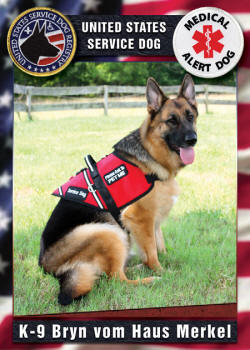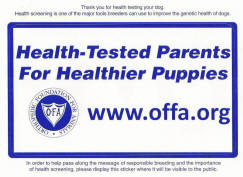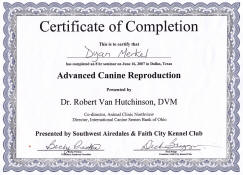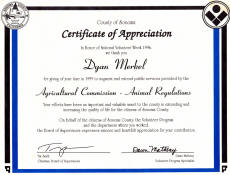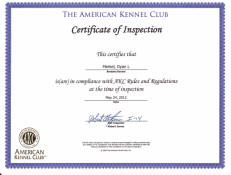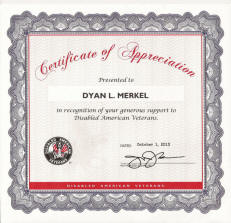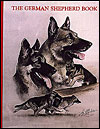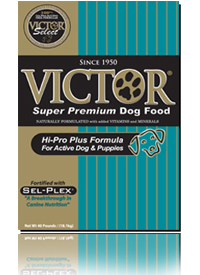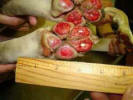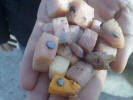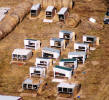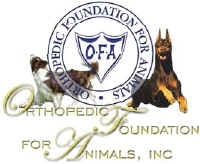PRE-BREEDING EXAM
FOR THE BITCH
A
few procedures performed before the bitch
comes in heat may make all the difference in
producing a litter of live healthy puppies.
These procedures will contribute to the
continued good health of your bitch. Also,
they ensure the safety of the stud dog if a
natural breeding should desired, and they
can help protect the stud dog's reputation
by preventing unnecessary breeding failures.
We like to start about one month before the
coming heat, in order to have time to treat
any problems found.
The most
common factor in missed litters is the
condition of the uterus. Changes to the
uterus occur because of low grade bacterial
infection, and the progesterone stimulation
that occurs in the 'false pregnancy'
experienced by every bitch following her
heat. Progesterone causes changes in the
uterine lining and additionally lowers
resistance to bacterial infections. The full
breeding cycle in the bitch not 3 weeks, but
4 months, due to the hormonal false
pregnancy. Some bitches show outward
physical and behavioral signs of a false
pregnancy, others don't, but they all have
elevated progesterone levels that affect
disease resistance and the uterine lining.
If a bitch cycles once a year, every 8
months, or every 6 months, she has time for
the uterine lining to rest and normalize.
Bitches that cycle every 4 months have no
such rest period. These short-cyclers,
therefore, are more likely to have the
condition known as cystic hyperplasia. They
are also, for the same reasons, more likely
to suffer chronic low grade infection and
inflammation in the uterus. The result of
these latter two conditions is a build up of
diffuse scar tissue in the endometrium. It
also follows that every year older the bitch
is, the greater the build up of damage from
these causes.
Bitches
that short-cycle should have periodic white
blood counts, and possibly
mibolerone treatment (formerly 'Cheque
Drops') to monitor for the development of
pyometra and to limit ongoing endometrial
damage.
CULTURE,
SENSITIVITY, AND WHITE BLOOD COUNT
No
matter how clean the environment, there will
be a continual supply of bacteria (mostly of
fecal origin), present where the bitch sits.
Every time she has a heat, her cervix opens
and bacteria can move into the uterus. In
humans, upright posture and gravity tend to
work against infections ascending from the
external genitalia. Dogs don’t have this
asset. If ‘vaginitis’ (an infection in the
vagina) is present and fairly well
established in the bitch when her cervix
opens, the infection may gain entry to the
uterus where it may become an ‘endometritis’
or a ‘pyometritis’. An endometritis is an
inflamed uterus, and a pyometritis is the
condition of frank pus in the uterus.
The
factors that cause a uterus to become an
unsuitable place for puppy development are
scar tissue, inflammation and continual
stimulation of the uterine lining. The
causes of scar tissue and inflammation are
low grade bacterial infections. So, while
the developing puppy may not be literally
attacked by harmful bacteria residing in the
uterus, bacteria can contribute
significantly to the deterioration of the
uterine environment. Any bacteriologist will
tell you that any organism can be
pathogenic in large numbers. On the other
hand, we don't really need or expect to wipe
all bacteria with antibiotic treatment, but
we hope to keep the numbers of these
bacteria below the level where it would be
expected to interfere with conception and
gestation. Some especially dangerous
bacteria we do try to eliminate.
Additionally, some bacteria can contribute
to neo-natal puppy death (as opposed to
puppy loss during gestation).
In order
to gauge whether a positive bacterial
culture means a vaginitis, an endometritis,
or a pyometritis, we must always do a white
blood count. The culture-and-sensitivity,
and the white count work together to
generate information in a useful form.
Keeping in mind that the entire animal must
be evaluated for other reasons for an
elevated WBC, in intact bitches in otherwise
good health, a normal to mildly elevated
count with a positive culture usually
indicates a vaginitis. A moderately elevated
white count implies a severe vaginitis or an
endometritis, and a white count of 30,000
and above is a severely affected uterus; in
this last condition, the uterus may be
distended with pus which can be felt by
palpation and may be visualized on ultra
sound or x-ray exam. This is then known as
pyometra.
NOTE:
bitches with pyometra will either exhibit no
signs at all, or mild depression and perhaps
some loss of appetite. There may be a thick
creamy discharge, but just as often there is
not. If the disease has progressed to the
pyometritis point, it is well beyond the
point we like to have caught it. One way to
monitor your bitch and avoid such an extreme
problem is to do a white blood count about 3
weeks after each heat period whether or not
she has been bred.
If an
infection exists and the white count is
high, the pyometra is treated with the
administration of prostaglandin therapy to
open the cervix and empty the uterus in
order to get the infection under control,
along with concurrent antibiotic therapy.
Those bitches with a frank pyometra and an
extremely high white blood count may become
septicemic, toxic, shocky and die if not
caught in time. Bitches that are followed in
a routine manner are caught before they
become too toxic and can be treated
effectively, and at least 85% should be able
to return to normal fertility.
To
determine if a uterine infection exists, a
bacterial culture and sensitivity should be
done using a ‘guarded culture instrument’.
The culture is taken high in the vagina,
near the cervix, and is termed a ‘high
culture’ or a ‘cervical culture’. We find
that sometimes even young bitches that have
not been bred before may have significant
numbers of bacteria that are capable of
being uterine and reproductive pathogens, as
well as very elevated white blood counts
indicating a uterine infection. We always
tell people that the reason we have to check
on even maiden bitches, is that the bitches
don’t wear panties (and the dogs aren’t
circumcised)!
The use of
a guarded culture instrument or a sterile
stainless steel speculum will ensure that
the organisms come from the area near the
cervix, rather than the area around the
vulva. If a guarded culturette or a
stainless speculum is not used, the culture
will be contaminated by the organisms the
bitch last sat on, rather than those that
are actually in residence near the cervix.
Using proper instrumentation and technique,
there is virtually no possibility of
introducing bacteria from the lower vagina
to the area near the cervix; those who claim
this will happen, probably do not have the
instrumentation and know-how to perform the
procedure properly, and a qualified
reproductive practitioner should be located.
A
sensitivity is performed along with the
culture. This is done in a petri dish filled
with a culture medium which will support the
growth of most bacteria. The culture swab is
swept evenly over the medium, to provide a
solid growth pattern. Then, small discs of
blotter paper, each impregnated with a
different antibiotic, are placed on this
surface. Where the growth of bacteria is
prohibited in a circle around the disc it is
said that that organism is ‘sensitive’ to
that antibiotic. Where there is no
interruption in the growth of the bacteria
around the disc, the organism is said to be
‘resistant’ to that antibiotic. This gives
us our third item of useful information;
what antibiotic to chose to treat the
infection.
Many
breeders who aren't exactly certain of what
each of these procedures are, think that a
vaginal swab, used by some to evaluate
breeding readiness, means a culture has been
taken. The vaginal swab us used to transfer
the epithelial cells lining the vagina to a
slide. These cells are stained and examined
for the amount of keratinization they
exhibit. This has nothing to do with a
culture/sensitivity.
If an
infection is found that warrants antibiotic
therapy, four to seven days after treatment
has been completed, a follow-up culture is
necessary to be sure the organism has been
eliminated, or reduced in numbers below an
acceptable level. It is important to obtain
the actual report of the lab on the culture
and sensitivity, as many labs are incorrect
in which organisms they identify as
‘significant’ in a reproductive infection. A
report of ‘clean’ or ‘no significant
organisms’ is not sufficient.,/P>
The
organisms we generally feel are significant
in a properly obtained cervical culture are
: beta Strep, E. coli, Pseudomonas spp., and
Staph aureas, as well as several others if
they are found in large numbers.
Additionally, we check for Mycoplasma, an
organism that is cultured in a different
manner. Mycoplasma is responsible for kennel
wide sterility is some instances. In other
examples, a bitch may whelp a litter even
though she has Mycoplasma in residence. In
fact, it is a 'normal inhabitant' in the
reproductive tract. However, normal does not
mean desirable, and if the culture comes
back with a moderate or heavy growth report,
we treat for it to reduce the level of
organisms. There is controversy about just
how important a pathogen it is, but years of
clinical experience and sterility in dogs
that have been infected suggest that it is
not prudent to neglect this organism.
Mycoplasma cultures are processed
differently than the standard aerobic
cultures and take a bit longer to grow. We
prefer to obtain cultures about a month
before the bitch is expected in heat, which
gives us time to get all of the necessary
information, and to give antibiotics if
necessary without having to worry about
getting it done before the time for
breeding.
THYROID
Thyroid is the basic ‘trophic’ hormone in
the body; trophic means promoting or
supporting growth. In order for all of the
more specific reproductive hormones to play
their proper role in the very complex series
of events resulting in successful production
of a litter, thyroid must be present at an
adequate level.
It can be
misleading to consider a 'lab normal’ range
for T4 as the appropriate range for
successful pregnancy. In terms of
reproduction, we are not interested in what
is a normal level for an aged animal. We
need to know normal T4 for a bitch of 1.5 to
5 years of age when trying to judge if there
is a sufficient thyroid level to support
pregnancy. We have no breed and age
break-downs in those lab normal ranges. Even
though the labs have been computerized for a
long time, most submitting veterinarians
neglect to note down the breed when they
submit their samples. Thyroid requirements
vary with age and with stress and disease
demands. Thyroid normals from labs will
include unhealthy dogs, and not reflect the
'euthyroid' of those included in the range.
The best
way to generate normal thyroid levels for
your breed is to organize a blood clinic at
a national specialty; in this way, we can
obtain thyroid levels of healthy dogs of
ages ranging from 6 months to veterans. When
the values obtained are sorted by age, you
will have a good idea of normal thyroid for
a dog of your breed and age.
The bitch
for which we may recommend l-thyroxine
supplementation to assure that this is not
the factor preventing a breeding from being
successful, is not a bitch that we would say
had abnormal thyroid function. If the dog
were exhibiting clinical signs of a true
thyroid deficiency, she would not be the one
you would be proposing to breed anyway. She
would be an unthrifty and unhealthy looking
animal. Many of the normal breeding animals
I check have a T4 in the low normal range.
Many of them are older than 5 years of age;
some of them also have Lyme disease. I feel,
and this is an opinion I have discussed with
several endocrinologists, that we should try
to have bitches in the upper third of the
normal range to assure that thyroid is not a
limiting factor for pregnancy. Almost every
bitch of 5 years or more will have a
relatively low thyroid, when compared to her
thyroid (T4) at a younger age. This a normal
sign of aging. As human women should
reproduce before 40, bitches should
reproduce before 5. Yet through the simple
act of supplementing l-thyroxine, we are
most often able to extend that breeding
range to 9 years, all other things being
equal. The argument as to whether we should
be breeding bitches with low thyroids is, in
my mind, totally useless until we take a
better look at the validity of published
ranges.
A thyroid
panel, such as the OFA panel, should be
obtained on a young healthy bitch in order
to reflect the true euthyroid condition of
the animal. Thyroid varies just like body
temperature throughout the day; for a normal
appearing and functioning animal, the ball
park T4 is all we need to evaluate before
breeding.
In a
younger bitch that has had trouble
conceiving and has a low (or low normal) T4,
often once a successful pregnancy has been
established and the bitch is checked again
after she has finished with weaning and
shedding, she may be able to go off
supplementation and maintain higher levels
of T4 on her own. Again, rechecks are
necessary to determine needs, if any as the
bitch’s age and circumstances change. It is
not a certainty that a bitch with a low
normal T4 can’t have a normal heat, become
pregnant and whelp a litter; rather, it is a
matter of trying to cover the bases and
eliminate areas where potential problems can
occur in order to enhance our chances of
producing the litter.
BRUCELLA
The owner
of the stud dog should always require that a
Brucella titer be done within the month or
so prior to a breeding. Unless artificial
insemination is a certainty, or even if just
normal courtship behavior is anticipated, it
is necessary to protect the male, and any
future bitches that might come to him. It is
contagious, and will render dogs and bitches
infected with it totally sterile. Brucella
is a true venereal disease, whereas the
infections we have discussed previously
arise from the environment. It is likewise
reasonable that the stud dog owner request
that all of the tests we have discussed
should be done, to protect the stud dog’s
health and fertility, and to protect his
reputation as a sire.
LYME
DISEASE, MONTHLY HEARTWORM AND PREGNANCY
Click here
for a complete discussion of the influence
of Lyme disease and monthly heartworm
medication on pregnant bitches. Suffice to
say here, no breeding animal, whether dog or
bitch, should ever be on any monthly or
injectable heartworm medication. Daily
preventives such as Filaribits or Nemacide
are safe to use.
The
following tests are reasonable for the stud
dog owner to request the bitch owner to do
before a breeding. Even if artificial
insemination is used, no stud dog owner
wants her dog's reputation for producing
puppies to suffer because the bitch wasn't
worked up. These same tests will help ensure
the breeder of a normal healthy litter.
- LYME WESTERN BLOT OR
IDEXX SNAP-3D LYME TEST (differentiates
between vaccinal and natural Lyme
exposure)
- BRUCELLA TITER
- CULTURE AND
SENSITIVITY (aerobic)
- CULTURE (Mycoplasma)
- WHITE BLOOD COUNT
- THYROID TEST (T4)
If the bitch is over 4 or has had a
'miss' on a prior breeding
|

